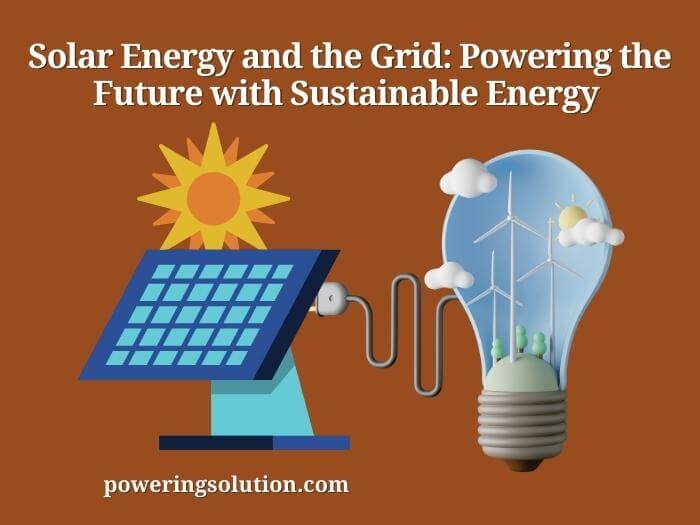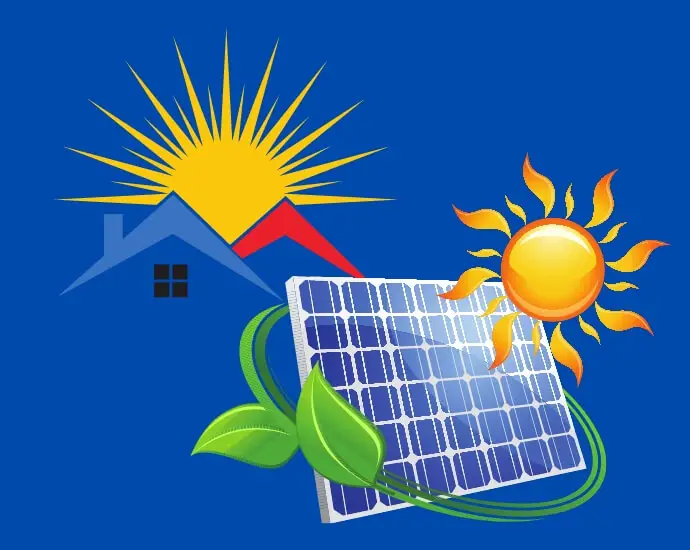In recent years, the global community has shown growing concern for climate change and the impact of human activity on the environment. One of the main culprits of environmental damage is the use of fossil fuels for energy production.

To combat this, solar energy has emerged as a promising alternative to traditional energy sources. The integration of solar energy into the grid presents a unique set of challenges. In this article, we will explore the benefits and challenges of solar energy, as well as the ways in which it can be integrated into the grid.
What is Solar Energy and the Grid?
Solar energy and the grid refer to the integration of solar energy into the existing power grid infrastructure. Solar energy is generated by capturing the energy from the sun through the use of solar panels, which convert the energy into electricity. The electricity generated by solar panels can be used to power homes, businesses, and other buildings.
The grid refers to the network of power plants, transmission lines, and distribution systems that make up the electrical infrastructure. The grid is responsible for ensuring that there is a constant supply of electricity to meet the needs of consumers. When solar energy is integrated into the grid, it becomes part of the larger system that delivers electricity to homes and businesses.
The integration of solar energy into the grid presents several challenges. One of the main challenges is that solar energy is intermittent, meaning that it is only available when the sun is shining. This can create issues for grid operators who need to balance energy supply and demand in real time. When there is too much solar energy on the grid, it can cause instability and even blackouts. When there is not enough solar energy, grid operators need to supplement it with other sources of energy.
To address these challenges, grid operators are using a range of strategies to integrate solar energy into the grid. These strategies include the use of smart grid technologies, energy storage systems, and distributed energy resources. Smart grid technologies use advanced sensors and communication technologies to monitor energy supply and demand in real time. This allows grid operators to balance energy supply and demand more effectively, even when there is a large amount of solar energy on the grid.
Energy storage systems, such as batteries, can store excess solar energy during the day and release it during periods of high demand. This helps to balance energy supply and demand and ensures that solar energy is available when it is needed. Distributed energy resources, such as rooftop solar panels, can generate energy closer to where it is needed, reducing the need for long-distance transmission lines.
The integration of solar energy into the grid requires a shift in the way that energy markets are structured. Energy markets have been based on the concept of baseload power, which refers to the minimum amount of power needed to meet energy demand. This has led to a reliance on large, centralized power plants that can produce a steady supply of energy around the clock. Solar energy is not suited to this model, as it is intermittent and varies throughout the day. Energy markets need to be structured in a way that allows for more flexible and dynamic energy supply and demand.
The Benefits of Solar Energy
Solar energy has several benefits that make it an attractive alternative to fossil fuels. First and foremost, it is a clean and renewable energy source. Unlike fossil fuels, which produce harmful greenhouse gases when burned, solar energy produces no emissions. This makes it an ideal choice for combating climate change and reducing our carbon footprint. Additionally, solar energy is abundant and widely available. According to the National Renewable Energy Laboratory (NREL), the amount of solar energy that reaches the earth’s surface in just one hour is enough to power the entire world for a year.

Another benefit of solar energy is that it can reduce our dependence on fossil fuels. Fossil fuels are a finite resource, and as they become scarcer, their price will continue to rise. This will make it increasingly difficult for countries to meet their energy needs. By investing in solar energy, countries can reduce their dependence on fossil fuels and ensure a more stable energy supply.
Solar energy can provide economic benefits. Solar panels have become increasingly affordable over the years, and the cost of solar energy has dropped significantly. In many parts of the world, solar energy is now cheaper than fossil fuel-based energy. This makes it an attractive option for businesses and homeowners alike. Investing in solar energy can create jobs in the renewable energy sector, which is expected to grow significantly in the coming years.
Challenges of Solar Energy
While solar energy has many benefits, it also presents several challenges. One of the biggest challenges is that solar energy is intermittent. This means that it is only available when the sun is shining. This can create challenges for grid operators, who need to balance energy supply and demand in real time. When there is too much solar energy on the grid, it can cause instability and even blackouts. When there is not enough solar energy, grid operators need to supplement it with other sources of energy.
Another challenge of solar energy is that it requires a significant amount of land. Solar panels need to be placed in areas that receive a lot of sunlight, which often means placing them in rural areas or on the outskirts of cities. This can make it difficult to integrate solar energy into the grid, as it may require building new transmission lines and infrastructure.
Solar energy can be expensive to store. While batteries have become more affordable in recent years, storing large amounts of energy for long periods of time can still be costly. This means that solar energy is not always available when it is needed, which can create challenges for grid operators.
Integration of Solar Energy into the Grid
Despite the challenges, solar energy can be successfully integrated into the grid. One of the keys to integrating solar energy is to use smart grid technologies. Smart grids use advanced sensors and communication technologies to monitor energy supply and demand in real time. This allows grid operators to balance energy supply and demand more effectively, even when there is a large amount of solar energy on the grid.
Another way to integrate solar energy into the grid is to use energy storage technologies. Battery storage systems can store excess solar energy during the day and release it during periods of high demand. This helps to balance energy supply and demand and ensures that solar energy is available when it is needed.
The integration of solar energy into the grid can be facilitated by the use of distributed energy resources (DERs). DERs are small-scale power generation systems, such as rooftop solar panels, that are connected to the grid. By using DERs, energy can be generated closer to where it is needed, reducing the need for long-distance transmission lines.
The integration of solar energy into the grid also requires careful planning and coordination. Grid operators need to have a clear understanding of how much solar energy is available at any given time, as well as how much energy is being consumed. This requires advanced forecasting tools and real-time monitoring systems.
The integration of solar energy into the grid requires a shift in the way that energy markets are structured. Energy markets have been based on the concept of baseload power, which refers to the minimum amount of power needed to meet energy demand. This has led to a reliance on large, centralized power plants that can produce a steady supply of energy around the clock. Solar energy is not suited to this model, as it is intermittent and varies throughout the day. Energy markets need to be structured in a way that allows for more flexible and dynamic energy supply and demand.
People Also Asked
What Are the Challenges of Integrating Solar Energy Into the Grid?
One of the main challenges of integrating solar energy into the grid is that it is intermittent, meaning that it is only available when the sun is shining. This can create issues for grid operators who need to balance energy supply and demand in real time. Additionally, the integration of solar energy requires a shift in the way that energy markets are structured.
How Can Grid Operators Balance Energy Supply and Demand When Solar Energy is Intermittent?
Grid operators are using a range of strategies to balance energy supply and demand when solar energy is intermittent. These strategies include the use of smart grid technologies, energy storage systems, and distributed energy resources.
Smart grid technologies use advanced sensors and communication technologies to monitor energy supply and demand in real time, while energy storage systems can store excess solar energy during the day and release it during periods of high demand.
What is the Future of Solar Energy and the Grid?
The future of solar energy and the grid is bright. With continued investment in solar energy and innovative solutions for grid integration, we can work towards a cleaner, more sustainable energy future. The integration of solar energy into the grid is an important step towards a more resilient and reliable energy system that is better equipped to meet the needs of consumers while reducing our reliance on fossil fuels.
Last Assumption
Solar energy is a promising alternative to traditional energy sources. It is clean, renewable, and widely available, and has the potential to reduce our dependence on fossil fuels. The integration of solar energy into the grid presents a unique set of challenges.
These challenges can be overcome through the use of smart grid technologies, energy storage systems, and distributed energy resources. By addressing these challenges and shifting the way that energy markets are structured, we can create a more sustainable and resilient energy system for the future. With continued investment in solar energy and innovative solutions for grid integration, we can work towards a cleaner, more sustainable energy future.
